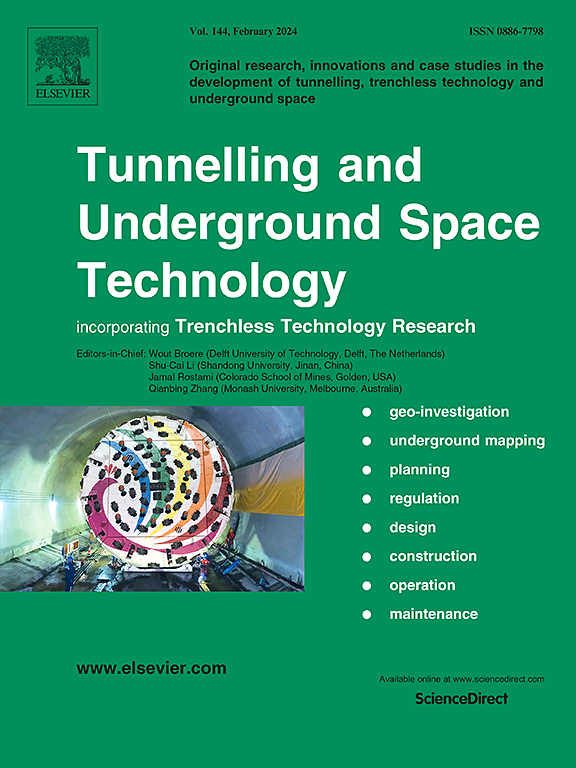A new early warning method for rockbursts and compound rockburst–collapse hazards in deeply-buried tunnels based on energy density
IF 7.4
1区 工程技术
Q1 CONSTRUCTION & BUILDING TECHNOLOGY
引用次数: 0
Abstract
Rockbursts and compound rockburst–collapse hazards frequently occur when deeply-buried tunnels are constructed in regions subject to significant geological variation and intense tectonic activity. These hazards are characterized by their sudden and highly destructive nature, thus posing a major threat to construction safety and engineering stability. The evolution of such hazards is usually accompanied by microseismic (MS) events that alternate between two different phases: long, quiet periods and short periods of eruption. Accurately identifying the transition interval between these phases (thus allowing hazard warnings to be issued in a timely manner) has thus become a critical issue that needs to be solved in current hazard warning systems. To address this issue, this paper proposes a new warning method based on the spatial evolution patterns of the MS events that occur during the development of rockbursts and compound rockburst–collapse hazards. We call it the ‘logarithmic energy density’ (logED) method as the indicator used is the logarithm of the energy density of the effective MS events released within the warning unit employed. It can be calculated using the WOA-DBSCAN clustering method and Quickhull3D algorithm. In this paper, five hazard cases are taken from a tunnel engineering project in southwestern China to use as study objects. The evolution characteristics of logED associated with these hazards as they evolve were systematically analyzed. The results show that logED can effectively capture the subtle and critical spatial distribution changes of the MS events in the precursor phase of the hazards and accurately identify the transition interval between long, quiet periods and short, eruption periods during the evolution phase. Compared with traditional hazard warning methods based on the logarithm of the MS energy released, logED has significant advantages in terms of improved prediction accuracy and sensitivity. Furthermore, the hazard warning method proposed in this paper is multi-parameter. That is, it combines an analysis of the changes in logarithmic MS energy released and logED, which allows it to precisely capture the subtle spatial distribution changes of the MS events and identify key transitional moments during the hazard evolution period. This effectively eliminates many misjudgments that often occur using single-parameter analysis methods. The proposed method provides new data dimensions and analytical tools for hazard prediction, significantly improves the scientificity and accuracy of the hazard warnings, and offers important theoretical support and practical guidance for the improvement and optimization of hazard warning systems.
基于能量密度的深埋隧道冲击地压及冲击塌陷复合灾害预警新方法
在地质变化大、构造活动剧烈的地区施工深埋隧道,经常发生岩爆和复合岩爆塌陷灾害。这些灾害具有突发性和破坏性强的特点,对施工安全和工程稳定构成重大威胁。这种灾害的演变通常伴随着微地震(MS)事件,这些事件在两个不同的阶段之间交替发生:长时间的安静期和短时间的喷发期。因此,准确识别这些阶段之间的过渡间隔(从而使灾害警报及时发布)已成为当前灾害预警系统中需要解决的关键问题。针对这一问题,本文提出了一种基于冲击地压和冲击塌陷复合灾害发展过程中MS事件空间演化规律的预警方法。我们称之为“对数能量密度”(logED)方法,因为所使用的指标是在所使用的预警单元内释放的有效MS事件的能量密度的对数。它可以使用WOA-DBSCAN聚类方法和Quickhull3D算法进行计算。本文以西南地区某隧道工程为研究对象,选取了5个危害案例。系统分析了与这些灾害相关的测井演化特征。结果表明,测井能够有效捕捉灾害前兆MS事件的细微和关键空间分布变化,准确识别演化阶段长安静期和短喷发期的过渡区间。与传统的基于MS能量释放对数的灾害预警方法相比,log在提高预测精度和灵敏度方面具有显著优势。此外,本文提出的危险预警方法是多参数的。即结合对MS释放和记录的对数能量变化的分析,可以精确捕捉MS事件的细微空间分布变化,识别灾害演化期间的关键过渡时刻。这有效地消除了使用单参数分析方法经常出现的许多误判。该方法为灾害预测提供了新的数据维度和分析工具,显著提高了灾害预警的科学性和准确性,为灾害预警系统的改进和优化提供了重要的理论支持和实践指导。
本文章由计算机程序翻译,如有差异,请以英文原文为准。
求助全文
约1分钟内获得全文
求助全文
来源期刊

Tunnelling and Underground Space Technology
工程技术-工程:土木
CiteScore
11.90
自引率
18.80%
发文量
454
审稿时长
10.8 months
期刊介绍:
Tunnelling and Underground Space Technology is an international journal which publishes authoritative articles encompassing the development of innovative uses of underground space and the results of high quality research into improved, more cost-effective techniques for the planning, geo-investigation, design, construction, operation and maintenance of underground and earth-sheltered structures. The journal provides an effective vehicle for the improved worldwide exchange of information on developments in underground technology - and the experience gained from its use - and is strongly committed to publishing papers on the interdisciplinary aspects of creating, planning, and regulating underground space.
 求助内容:
求助内容: 应助结果提醒方式:
应助结果提醒方式:


